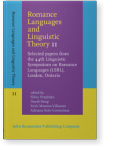Chapter 6
The morphological markedness of φ
Evidence from perfective auxiliaries in Southern Italian dialects
This paper investigates the morphological markedness of φ features encoded on perfective auxiliaries in a subset of Upper Southern Italian dialects (USIDs).
Following a Distributed Morphology approach (cf. Halle & Marantz 1993, 1994, a.o.), we treat perfective auxiliaries in USIDs as syntactic heads composed of Tense and φ features whose phonological entries are inserted at PF by means of a process called Spell-Out.
Here, we argue that the overt marking of φ features attested on perfective auxiliaries in a group of USIDs depends on the application of a post-syntactic operation called Default Marking, according to which a dedicated set of φ features gets overtly marked only if its grade of markedness is uniform with the one expressed by Tense.
Article outline
- 1.Introduction
- 2.The typology of morphological markedness of φ on perfective auxiliaries in CSIDs
- 3.Auxiliaries in CSIDs
- 4.The morphophonological markedness of φ on perfective auxiliaries in CSIDs: The operation of Default Marking
- 4.1The uniformity of markedness in INFL
- 4.2The Default Marking
- 5.Summary and conclusions
-
Notes
-
References
